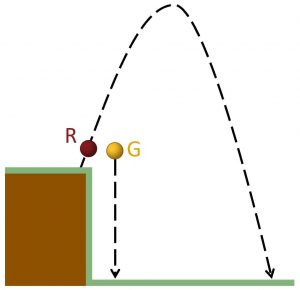19 Conservation of Energy – Closed Systems
Brokk Toggerson
We have already briefly discussed conservation of energy in a prior chapter and I am sure you have seen it in other science courses. In this chapter, we shall see a few applications of this critical concept in some closed systems from a physics perspective.
What is a Closed System Anyway?
A is one where energy cannot enter or leave. It can be exchanged among the objects within the system, but cannot leave, nor can more energy come in. In this sense, a closed system is like a bunch of people in a room passing money around: different people may have different amounts of it at different moments, but the total in the system does not change.
Examples of Conservation of Energy in Closed Systems
Example: Speed on Hitting the Ground
Problem:
A ball is thrown straight up with a speed of 5 m/s. How fast does it hit the ground ignoring any effects of air resistance?
Solution:
Example: Speed on Hitting the Ground – Different Paths
Problem:
Two balls are thrown off a cliff: one (red – R) is thrown straight up, and one (gold – G) is thrown straight down. Both are thrown with the same speed of 3 m/s. Which hits the ground with the higher speed?

Solution:
Example: Spring Pendulum (T.I.P. 3 and 4 pp 92)
Problem:
A ball on the end of a spring makes a pendulum as in the video below. As you can see, the ball starts with the spring relaxed and parallel to the ground. As it falls, the spring stretches.
At which point (the spring parallel to the ground or the ball at the bottom) is:
- The gravitational potential energy maximized?
- The elastic potential energy of the spring maximized?
- The kinetic energy of the ball maximized?
- The total energy at a maximum?
Solution:
a. Where is the gravitational potential energy maximized?
The gravitational potential energy is maximized when the ball is at its highest above the ground: when the spring is parallel to the surface of the Earth.
b. Where is the elastic potential energy of the spring maximized?
The elastic potential energy is at its largest when the spring is deformed the most. That appears to happen when the ball is at the bottom of its path.
c. Where is the kinetic energy maximized?
The kinetic energy depends on the speed. Thus, this hits its maximum when it is moving the fastest: again at the bottom of the swing.
d. Where is the total energy at a maximum?
The total energy never changes (conservation of energy). Thus, the initial gravitational potential energy is converted to elastic potential energy and kinetic energy as it falls.
Homework
- A skateboarder and dog’s kinetic energy.
- Speed at the bottom of different slides.
- From different heights, speed when meets the ground.
A collection of objects where energy cannot enter or leave. It can be exchanged among the objects within the system, but cannot leave, nor can more energy come in.

